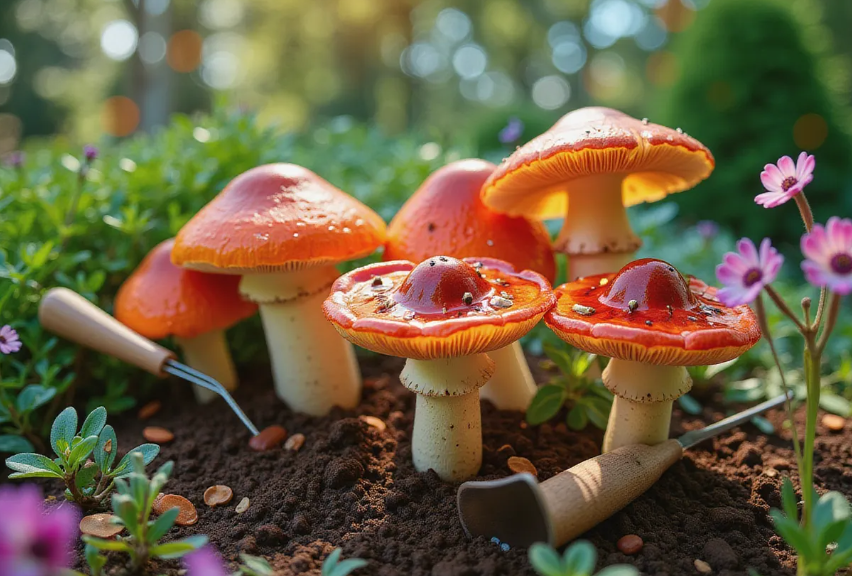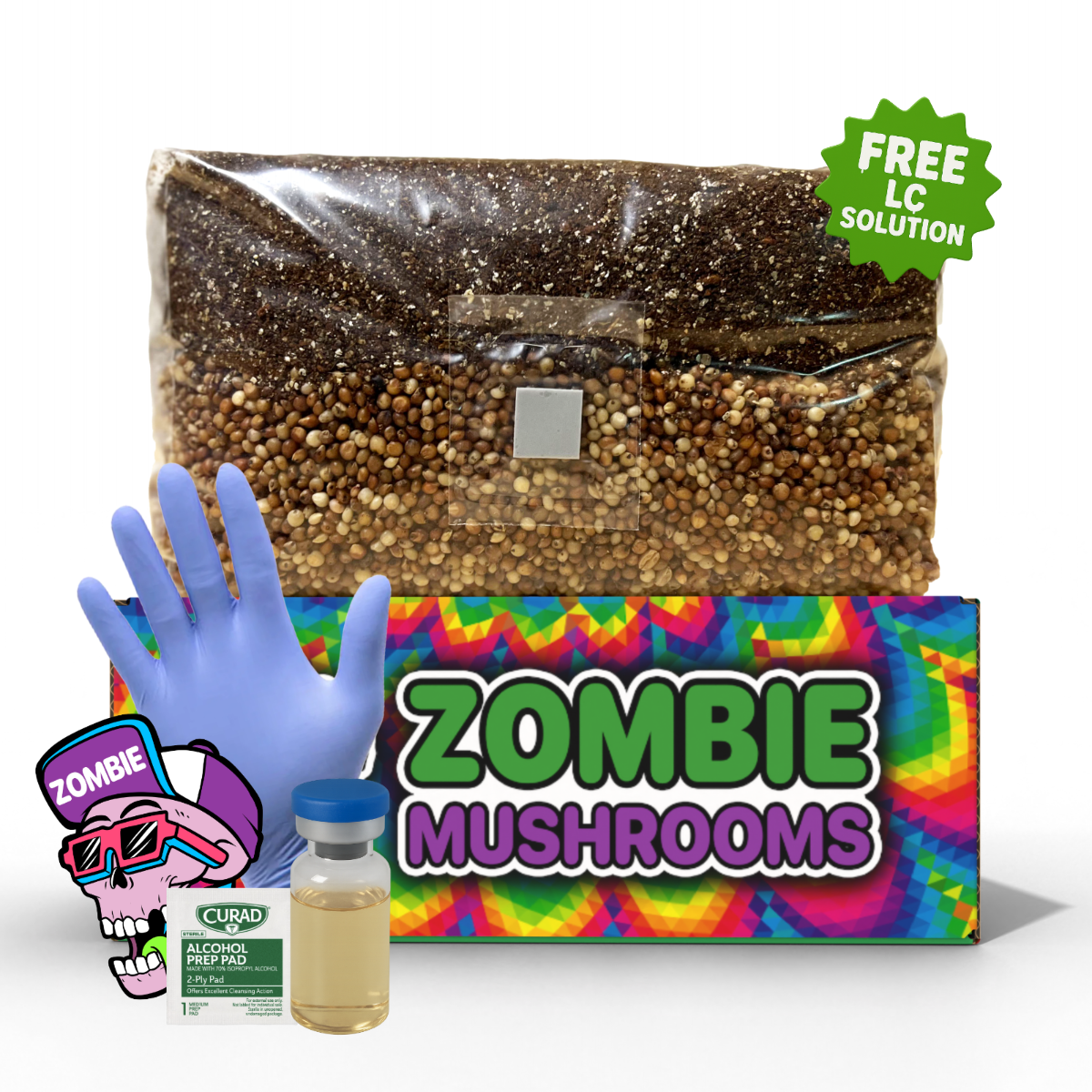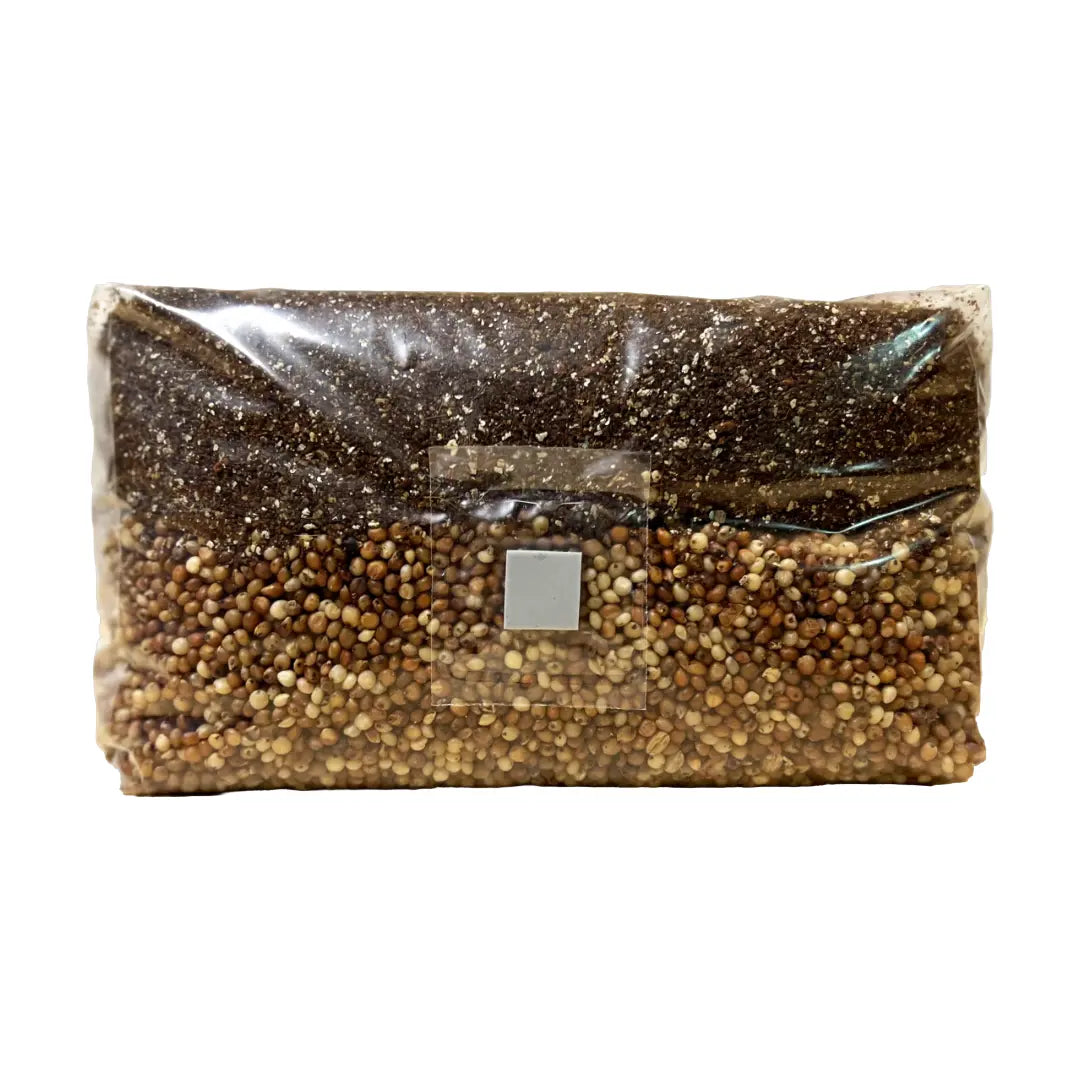⬇️ Prefer to listen instead? ⬇️

- Wine cap mushrooms improve garden soil. They also stop weeds and pests.
- Mushroom beds outside copy nature. This helps get more mushrooms and be sustainable.
- Good wine cap beds grow mushrooms for 2–4 years. You need to add more stuff each season.
- Mycelium grows best when it's 50–75°F (10–24°C).
- You must know wine caps well. Some toxic mushrooms look like them.
Wine cap mushrooms (Stropharia rugosoannulata) are great for gardens and foragers. People also call them Garden Giants or King Stropharia. They taste good and get big. They help garden soil and all sorts of life in the garden. Many growers like starting them with mushroom grow bags, since they provide a reliable way to establish a healthy mycelium culture before transferring it outdoors. Healthy garden giants start here. Use our grow bags for the best results.
This guide will show you how to grow wine cap mushrooms outside. You'll learn why they are good for your garden. You'll also learn how to keep a mushroom bed going season after season.
Why Wine Cap Mushrooms Are Great Garden Friends
Wine cap mushrooms have been liked for a long time. They fit right into backyard life. These cool mushrooms get big. They have burgundy-colored caps. That's why they are called wine caps. They have thick, white stems. They taste good and are good for cooking. They have a mild, earthy, nutty taste. They also have a meaty feel. This makes them good for grilling, sautéing, or putting in stews and broths.
But wine caps (Stropharia rugosoannulata) do more than taste good. In permaculture gardens, these mushrooms break things down well. Their strong mycelium can grow on straw, wood chips, or shredded leaves. It breaks down these things into soil that is full of humus. This soil also has lots of tiny life in it. This makes the soil better. It also helps soil hold water and feed plants (Stamets, 2005).
Other good things are
- Weed Control: The thick mycelium stops weeds from growing. It takes up space and breaks down mulch fast.
- Pest Control: Wine cap beds might make root maggots and other soil pests less of a problem. They do this by making the soil have more kinds of tiny life.
- Life in the Garden: Mycelium helps the life under the ground. It feeds good bacteria. It also brings pollinators to the garden.
These helpful things make wine cap mushrooms a good friend to your garden. They change your garden from just one type of plant to a garden with many layers of life.

Why Wine Cap Mushrooms Grow Best Outside
Growing mushrooms inside is popular now. But wine cap mushrooms do best outside. They need things that are easy to find outside: leaves, wood chips, and wetness. Some mushrooms need special humidity and temperature inside. But wine caps do well when nature helps them.
Here's why you should grow them outside
- Natural Spot: Wine caps naturally grow in forest openings, compost, wood piles, and shady mulch paths.
- Easy Care: Once started, mushroom beds outside don't need much. Just wetness and adding more stuff each season.
- Cheap: Outdoor setups don't cost much. You just need spawn, mulch or chips, and some shade.
Outdoor mushroom beds also become soil helpers over time. The stuff that breaks down becomes good compost. And the mycelium keeps living below. The USDA National Agroforestry Center (2022) says fungi like wine caps are very important. They help cycle nutrients in gardens and recycle wood waste.
What You Need to Start
Starting a mushroom bed outside is easy. You don't need special tools. Here's what you need to grow wine cap mushrooms outside
Wine Cap Grain Spawn
This is like mushroom seed. The grain holds and feeds the living mycelium. Good sellers like Zombie Mushrooms have good spawn. It grows on grains like rye or millet. Keep it in the fridge if you don't use it right away.

Substrate Material
Wine cap mushrooms grow on things with lots of carbon. These things help them grow and give them energy. Good choices are
- Hardwood chips: They last a long time and have lots of nutrients. Good if you want a bed that lasts.
- Straw: It breaks down faster. It's easier to find, especially from local farms.
- Leaf litter: It works if you mix it with wood chips or straw. But it's not good by itself.
Don't use softwoods like pine or cedar. They can put bad stuff in the soil.
Cardboard or Newspaper
This stops weeds. It also gives the spawn a place to start growing. Soak it so it's easy to bend and use as a weed block.
Bed Edging (Optional)
Use logs, bricks, wood pieces, or plastic to mark the bed edges. This makes it look nice. It also helps keep water in.
Shady Spot
Wine caps like shade. Find a spot under trees or on the north side of a building. Shade that lets some light through is good. It keeps the bed from drying out.

Step-by-Step Guide: How to Make a Mushroom Bed Outside
Making a mushroom bed outside is like layering things. You put things in layers, space them out, and keep them wet. Think of it like making lasagna for mushrooms.
Step 1: Pick and Get Ready the Spot
Where you put the bed is important. Don't put it where it floods or gets too much sun. It should stay wet and cool. This is important in spring and fall.
Clear away weeds, rake the spot, and loosen the soil a little. This helps water drain.
Step 2: Put Down Cardboard
Lay down soaked cardboard sheets. Make them overlap. This stops weeds from growing. It also gives the mycelium something to eat. Worms will eat it too and move it around.
Step 3: Add Substrate Layer
Spread a layer of wood chips or straw. Make it 2–4 inches thick. Keep it even so it grows evenly. You can use both things or layer them. This makes it varied and last longer.
Step 4: Put in the Spawn
Sprinkle spawn all over the area. Break up clumps and spread it evenly. Rake it in a little. This helps it touch the chips well.
How much spawn to use
- 5 lbs of spawn per 25 sq ft for a thick, fast bed
- 2.5 lbs per 25 sq ft for a slower but cheaper way
Step 5: Layer Again (Lasagna Style)
Keep layering chips/straw and spawn. Do this until the bed is 4–8 inches deep. Top it with a layer of chips. This protects the mycelium from sun and wind.
Step 6: Water Well
Water is very important for mushrooms. Soak the bed well after making it. Make sure water goes through all layers. When it's dry, water every few days. Keep it damp, but not too wet.

Best Time to Start Your Bed
Plant wine cap mushrooms when the soil is 50°F to 75°F (10–24°C). This is usually
- Spring (March–May): Bed will grow by fall.
- Fall (September–October): Mushrooms will grow next spring.
Cool nights and wetter air are best then. They help mycelium grow fast. For the first six weeks after planting, keep it wet. This helps the mycelium grow all through the bed.

Taking Care of Your Wine Cap Bed
After planting, nature does most of the work. But some care will help get more mushrooms and make it last.
Care Checklist
- Water When Dry: If it's dry for several days, water the bed deeply once or twice a week.
- Add Mulch Each Season: Add more wood chips or straw each spring or fall. This feeds the mycelium and protects it from hot and cold.
- Weed Sometimes: In the first year, pull out big weeds that might take over.
- Check Mycelium Growth: Lift the edge of the bed now and then. Look for white threads. This means it's growing.
Mycelium can take months to grow all through the bed. Be patient and keep doing these things.

When and How to Pick Wine Cap Mushrooms
When your bed is ready (usually 4–12 months), you'll see burgundy caps coming up. This is more likely after rain.
Look For
- Round caps when young, dark red
- Gills that change from white to grayish-purple as they get older
- A white stem with a ring near the top
Best Ways to Pick
- Use a Knife: Cut at the base or just below the mulch. Don't pull them. This can hurt the mycelium below.
- Check Every Day When They Grow: Mushrooms can double in size overnight, especially in spring and fall.
- Pick Them Before They Get Too Old: Old mushrooms get soft and don't taste as good. They might also get slimy.

How to Keep Your Bed Growing for Years
Wine cap mushrooms eat material that breaks down slowly. So a good bed can keep growing mushrooms for 2–4 years if you take care of it (Smith & Doyle, 2019).
Tips to keep your wine cap bed going
- Add Substrate Each Year: Add a few inches of chips or straw each spring or fall.
- Let Spores Drop: Let some mushrooms get old and drop spores. This helps them grow naturally.
- Start a New Bed Nearby: Make new beds every 2–3 years. This spreads out the fungus and gets you more mushrooms.
- Add Spawn Again If Needed: If the bed slows down, add more grain spawn. This can help the mycelium grow again.

Very Important Safety Note: Know What You Eat
Wine caps are easy to spot, but some look-alike mushrooms can trick you. Always check carefully and be safe.
How to Know It's a Wine Cap
- Cap: Burgundy to reddish when young, turning tan
- Size: Big — up to 5–10 inches across
- Gills: White at first, turning purple-gray as they age
- Stem: Has a ring; thick and white
Check many guides before eating any wild mushrooms. Look at the North American Mycological Association guide. Or ask a mushroom expert.

Frequently Asked Questions (FAQs)
How long until wine cap mushrooms grow?
Anywhere from 4 to 12 months. It depends on the bed, weather, and wetness.
Can I plant them near vegetables?
Yes. Wine caps help many vegetables by making soil better and stopping root maggots.
Do they live through winter?
Yes, especially if the beds have good mulch. The mycelium rests but stays alive.
Can I grow them with other mushrooms?
Yes, but give each kind its own space. Wine caps grow fast and might take over from other types.
Popular Kits to Get Started
If you want to start, Zombie Mushrooms has kits for new and experienced growers
- Wine Cap Grain Spawn: Good spawn for making your own mushroom beds
- Lion’s Mane Mushroom Kit
- Blue-Grey Oyster Mushroom Kit
- Yellow-Gold Oyster Mushroom Kit
- Choose Any 2 Kit Bundle — Try different kinds and save money
Save Today With Discount Codes
Start your mushroom bed and save with deals and bundles. Tell a gardening friend or try different spawn types for more kinds of mushrooms.
Put Wine Cap Mushrooms in Your Garden
Learning to grow wine cap mushrooms is not just about food. It’s about caring for your garden as a living thing. These mushrooms give you lots of food with little work. They also make your soil and garden better over time. If you are trying permaculture or just want good food, wine caps are easy to add and last for years.
Ready to start? Check out wine cap spawn and kits from Zombie Mushrooms. Make your garden wild and wonderful.
Citations
- Stamets, P. (2005). Mycelium Running: How Mushrooms Can Help Save the World. Berkeley: Ten Speed Press.
- Smith, J., & Doyle, M. (2019). Outdoor mushroom beds as sustainable food sources. Journal of Permaculture & Sustainability, 12(3), 45-56.



